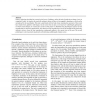Free Online Productivity Tools
i2Speak
i2Symbol
i2OCR
iTex2Img
iWeb2Print
iWeb2Shot
i2Type
iPdf2Split
iPdf2Merge
i2Bopomofo
i2Arabic
i2Style
i2Image
i2PDF
iLatex2Rtf
Sci2ools
CGF
2000
2000
Tone Reproduction for Interactive Walkthroughs
When a rendering algorithm has created a pixel array of radiance values the task of producing an image is not yet completed. In fact, to visualize the result the radiance values still have to be mapped to luminances, which can be reproduced by the used display. This step is performed with the help of tone reproduction operators. These tools have mainly been applied to still images, but of course they are just as necessary for walkthrough applications, in which several images are created per second. In this paper we illuminate the physiological aspects of tone reproduction for interactive applications. It is shown how tone reproduction can also be introduced into interactive radiosity viewers, where the tone reproduction continuously adjusts to the current view of the user. The overall performance is decreased only moderately, still allowing walkthroughs of large scenes.
| Added | 17 Dec 2010 |
| Updated | 17 Dec 2010 |
| Type | Journal |
| Year | 2000 |
| Where | CGF |
| Authors | Annette Scheel, Marc Stamminger, Hans-Peter Seidel |
Comments (0)

